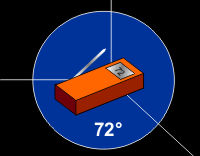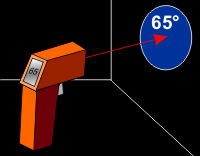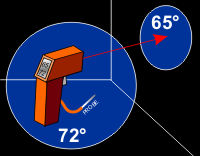UFO HUNTING 101UFO Hunting Equipment, Tips & Processes Since the beginning of time man has been curious about the what lies beyond the skies. Going back to cave drawings and hieroglyphics, evidence of existence beyond our world is told time after time. Since the beginning of time man has been curious about the what lies beyond the skies. Going back to cave drawings and hieroglyphics, evidence of existence beyond our world is told time after time.Let's all discover what's out there. Before The InvestigationFact Gathering & ResearchThe best tool at your disposal is 'the facts'. Our job as investigators is to gather as much information as possible. This information will be pertinent in conducting a professional, efficient and accurate investigation.
Required UFO Hunting GearFor safety and proper documentation I suggest having at the very least the following items on each person for every investigation.
Standard UFO Hunting Equipment & GearAudio Recorders
Audio recorders are a handy tool for documenting your investigation. There are two main types of audio recorders including:Digital Audio RecorderDigital audio recorder, a more recent technology, uses an internal hard drive to record audio. This gives you the ability to record many hours depending on the size of the internal drive. They are typically very small and include a manner in which to plug the device into your home computer to retrieve the audio data - typically via a USB connection. This audio is typically in a standard format such as MP3, WAV, or WMV - again, depending on the type of recorder you get. Most recorders will also allow you to separate out audio into folders making it easier to note which segment is for what.Most digital audio recorders require a separate USB cable. There are, however, models that plug right into your computer via USB without the need for a cable. I prefer this route as I am prone to losing things and I have enough random cables as it is. I don't need another one. These units I suggest as they do not require a separate cable. Olympus - Compact digital audio recorder has a built in USB plug (does not require a cable) and records with great quality up to 272 hours of audio. How Do You Transfer Audio From Your Digital Recorder To Your Computer?I get this question a lot. Now that you've gotten your digital audio recorder, how do you get the audio off the recorder on to your computer an clip out what you want. Since, all manufacturers do things slightly different you should really read the manual that came with your device for instructions on how to get the audio onto your computer. That aside, you can generally follow these basic steps:
With each of these applications you can visually see the audio levels while you're listing to it. To clip out what you want, simply select the preferred area with your mouse and Copy/Paste that section to a new file. Some applicatons may also have an option to save the selected area to it's own file. TIP: When clipping possible audio for evidence, select at least 30 seconds before and after the focal area. This helps those listening to get a better idea of what is happening during the time of the activity. CamerasOne of the basic function tools of every investigation is a camera. They can be used not only for photographing potential sightings and activity but for documenting your investigation proceedings. There are a number of types of cameras out there serving different purposes. Digital CamerasDigital cameras are, of course, the easiest to use. Because you can transfer high quality photos directly from a digital camera right to your computer it saves time and money in having to process film. The drawback, however, is that many are not as flexible with their settings and have (in many cases) and long lag period when taking photos.Camera Modifications (IR/Full Spectrum)Cameras can be modified to see further into the light spectrum than we can see with our naked eye. This gives us the ability to see areas of light normally unseen which may be being projected from extraterrestrial objects. On one end of the spectrum is Infrared (or IR) while on the opposite end is Ultraviolet (UV). Cameras can be modified through adjusting or removing filters to see deeper into either end of the spectrum. Conversion of the camera to see deeper into both IR and UV is called Full Spectrum.There are different theories as to what constitutes good Full Spectrum. In some cases the filter is removed and in others it is replaced to see IR and UV but NOT the visible spectrum. I consider the latter (where visible light is blocked) as a multi-spectrum modification, not Full Spectrum. While this method may be practical for daylight uses where bright visible light can overlap the IR and UV this is not an issue when conducting nighttime paranormal investigations in mostly dark. Suggested Cameras: Full Spectrum Digital Camera - Takes quality Full Spectrum photos and video with the convenience and ease of a compact digital camera Infrared (IR) Digital Camera - Takes quality IR photos and video with the convenience and ease of a compact digital camera EMF Meters (Electro Magnetic Field)EMF meters
measure fluctuations in electromagnet fields (or EM fields). It is believed that electromagnet field levels that may be present or left behind by an extraterrestrial object or paranormal source. Use an EMF meterfor a quick, reliable and accurate way to measure and document abnormal EM frequencies and temperature. Here at home these fields are typically a direct result of electrical appliances in home, cell phones, power lines outside and even fluctuations in solar activity and weather. Beyond that, a primary theory in the field of UFO research is that exterrestial objects and entities may emit or leave traces of EMF or can manipulate these fields. The units of measurement registered on an EMF meter is called milligauss. There
are a large number of EMF meters on the market with various features.
The two main differentiation are Single Axis and TriField (or tri-axis)
explained below. Single AxisSingle axis EMF meters, like all EMF
devices measure fluctuations in electromagnetic fields. These meters,
however, read these fluctuations in one direction. Typically this
direction is directly ahead of you (as you hold the device in front of
you with the display up). Suggested Single Axis Meters: Digital EMF Meter - This meter has a digital display for better accuracy in documenting specific readouts. TriField MetersTriField meters on the other hand, measure fluctuations in electromagnetic fields but in 3 axis - X, Y and Z. These devices measure in all directions. TriField Natural EM Meter - This meter is considered the best for paranormal investigation. This meter measures magnetic, electric and radio/microwaves focusing mainly on naturally occurring 'DC' fields. These currents are considered in the field moreso indicative of paranormal activity. TriField Meter - This meter offers magnetic, electric, and radio/microwave detection
in one package. Includes an analog readout and an adjustable audio
alert. This meter, however, focuses mainly on 'AC' or man-made
electrical and magnetic fields. This meter is moreso effective in
detecting man-made currents to debunk claims of 'being watched' which
can be caused by faulty wiring and/or electrical leakage. For detecting
paranormal activity, you're better off with the TriField Natural EM
Meter above. Camcorders / Video Cameras
Another basic tool for every investigation is some kind of video capture device. Camcorders (or handheld video cameras) have become a staple mainly along with the more recent affordability of them. They can be used not only for capturing sightings and extraterrestrial activity but for documenting your investigation. There are a number of types of camcorders, modifications and accessories to mold it to your use and investigation style. Full Spectrum Camcorders and Cameras
The PHOTO to the right is a comparison of 'OUR' Full Spectrum and 'The Other Guys' that block visible light. This quick test makes it quite obvious that, in dark situations, blocking visible light can be quite detrimental to documenting anything. Below is a VIDEO DEMONSTRATION of the Full Spectrum camcorder along with various lighting choices.
Full Spectrum HD Camcorder
- Modified Full Spectrum HD (High Definition) Camcorder with 12MP Camera. This video camera offers 1080p HD quality needed to capture clear evidence. This camcorder has been professionally modified with UV and IR sensitivity to view the full spectrum of light including light not seen with the human eye. Accessories All cameras (just like our eyes) require a good light source. Many can be attached directly to your camera using a shoe mount or tripod mount. The type of light source depends on the kind of camera you are using. An Infrared (IR) sensitive camcorder should be accompanied by an IR light source which is essentially a light that gives off only Infrared light. A Full Spectrum camera should be accompanied by a special Full Spectrum light source. Some people will use a bright white light source with a Full Spectrum camera. The downside to that is lighting up the whole room while you're investigating. This can be distracting to everyone in the investigation group. Suggested Lighting: Full Spectrum Light - Specially made for Full Spectrum video capture this Full Spectrum light has Infrared, Red, Blue, Green, and Ultravoilet LEDs for true full spectrum illumination. No white or clear light are emitted from them helping maintain a low light room while investigating. Laser GridHave you ever caught movement on camera and you can't quite make out it's shape or whether it even has a mass to it? Using a laser grid helps determine both! I
have been using custom made laser grids for years to more clearly
detect when movement happens and help define it's shape and whether it
actually has some kind of mass to it. It's best to place a laser grid
in front of a running camera throughout the investigation. Upon review
if movement happens it will be obviously apparent by the breaking of
the laser pattern. You can from there go frame by frame in the video
marking where the pattern shifts thereby drawing an outline shape of
the entity itself. If the pattern moves a certain way you can even
determine if the entity has 3-dimensional mass and map that as well. I
have been using custom made laser grids for years to more clearly
detect when movement happens and help define it's shape and whether it
actually has some kind of mass to it. It's best to place a laser grid
in front of a running camera throughout the investigation. Upon review
if movement happens it will be obviously apparent by the breaking of
the laser pattern. You can from there go frame by frame in the video
marking where the pattern shifts thereby drawing an outline shape of
the entity itself. If the pattern moves a certain way you can even
determine if the entity has 3-dimensional mass and map that as well.Suggested Lasers: Laser Grid Scope - his high powered laser emits a grid of green dots useful for detecting shadows or general visual disturbances during an investigation. Set it in front of a running camera to catch potential evidence. 6X STRONGER than the imitators.Shadow Laser Grid GS - This is a new grid we are working on that will be out soon. Keep an eye out! Motion Detectors
Ever received reports of alien abductions or activity in a client's home? It's relatively common. Motion sensors are a good way to detect movement. A motion sensor detects movement within a given range ahead of it and alerts you to the occurrence through an audio or visual alert. Suggested Motion Detectors: Motion Sensor
- Great compact motion sensor with visual and audio alerts. ThermometersYou may find cold or warm spots in a room where no cause in apparent. This may be indicative of something trying to make contact or traces left behind by extraterrestrial objects. To detect these anomalies, you will need a thermometer and a little common sense. If you find a cold spot, for instance, look for any possible source of the cooler temperature. Look for open vents, windows and fans as possible sources. Move the thermometer in every direction to find where the area starts and ends. If the anomaly is relatively concentrated in on area with no attachments to possible sources, you may have something attempting to manifest. This is the time to break out your cameras and audio recorders to attempt furthering your evidence with communication and/or visuals. The biggest mistake people make with thermometers, however, is using the wrong type. Here are the two main types of thermometers:
|


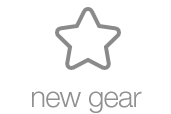

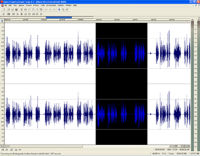 Now
that you've gotten the audio file onto your computer you're ready to
review the evidence. Once you've found something particularly
interesting you'll most likely want to clip out that section to send to
your team for review or put up on the internet, right? To do this, you
need a program capable of this. There are many out there, so here are a
few I suggest:
Now
that you've gotten the audio file onto your computer you're ready to
review the evidence. Once you've found something particularly
interesting you'll most likely want to clip out that section to send to
your team for review or put up on the internet, right? To do this, you
need a program capable of this. There are many out there, so here are a
few I suggest:

